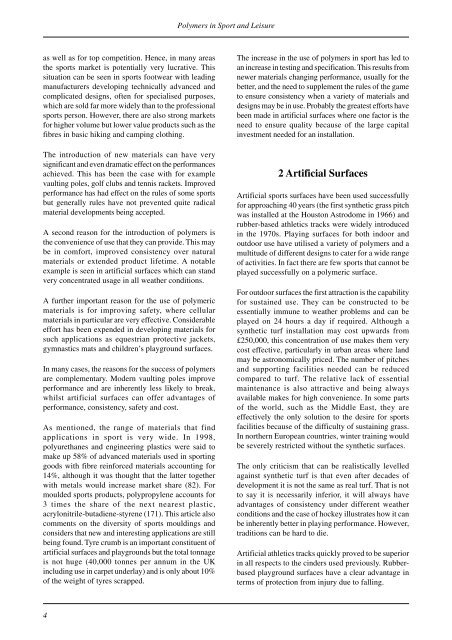Polymers in Sport and Leisure
Polymers in Sport and Leisure
Polymers in Sport and Leisure
Create successful ePaper yourself
Turn your PDF publications into a flip-book with our unique Google optimized e-Paper software.
<strong>Polymers</strong> <strong>in</strong> <strong>Sport</strong> <strong>and</strong> <strong>Leisure</strong><br />
as well as for top competition. Hence, <strong>in</strong> many areas<br />
the sports market is potentially very lucrative. This<br />
situation can be seen <strong>in</strong> sports footwear with lead<strong>in</strong>g<br />
manufacturers develop<strong>in</strong>g technically advanced <strong>and</strong><br />
complicated designs, often for specialised purposes,<br />
which are sold far more widely than to the professional<br />
sports person. However, there are also strong markets<br />
for higher volume but lower value products such as the<br />
fibres <strong>in</strong> basic hik<strong>in</strong>g <strong>and</strong> camp<strong>in</strong>g cloth<strong>in</strong>g.<br />
The <strong>in</strong>troduction of new materials can have very<br />
significant <strong>and</strong> even dramatic effect on the performances<br />
achieved. This has been the case with for example<br />
vault<strong>in</strong>g poles, golf clubs <strong>and</strong> tennis rackets. Improved<br />
performance has had effect on the rules of some sports<br />
but generally rules have not prevented quite radical<br />
material developments be<strong>in</strong>g accepted.<br />
A second reason for the <strong>in</strong>troduction of polymers is<br />
the convenience of use that they can provide. This may<br />
be <strong>in</strong> comfort, improved consistency over natural<br />
materials or extended product lifetime. A notable<br />
example is seen <strong>in</strong> artificial surfaces which can st<strong>and</strong><br />
very concentrated usage <strong>in</strong> all weather conditions.<br />
A further important reason for the use of polymeric<br />
materials is for improv<strong>in</strong>g safety, where cellular<br />
materials <strong>in</strong> particular are very effective. Considerable<br />
effort has been expended <strong>in</strong> develop<strong>in</strong>g materials for<br />
such applications as equestrian protective jackets,<br />
gymnastics mats <strong>and</strong> children’s playground surfaces.<br />
In many cases, the reasons for the success of polymers<br />
are complementary. Modern vault<strong>in</strong>g poles improve<br />
performance <strong>and</strong> are <strong>in</strong>herently less likely to break,<br />
whilst artificial surfaces can offer advantages of<br />
performance, consistency, safety <strong>and</strong> cost.<br />
As mentioned, the range of materials that f<strong>in</strong>d<br />
applications <strong>in</strong> sport is very wide. In 1998,<br />
polyurethanes <strong>and</strong> eng<strong>in</strong>eer<strong>in</strong>g plastics were said to<br />
make up 58% of advanced materials used <strong>in</strong> sport<strong>in</strong>g<br />
goods with fibre re<strong>in</strong>forced materials account<strong>in</strong>g for<br />
14%, although it was thought that the latter together<br />
with metals would <strong>in</strong>crease market share (82). For<br />
moulded sports products, polypropylene accounts for<br />
3 times the share of the next nearest plastic,<br />
acrylonitrile-butadiene-styrene (171). This article also<br />
comments on the diversity of sports mould<strong>in</strong>gs <strong>and</strong><br />
considers that new <strong>and</strong> <strong>in</strong>terest<strong>in</strong>g applications are still<br />
be<strong>in</strong>g found. Tyre crumb is an important constituent of<br />
artificial surfaces <strong>and</strong> playgrounds but the total tonnage<br />
is not huge (40,000 tonnes per annum <strong>in</strong> the UK<br />
<strong>in</strong>clud<strong>in</strong>g use <strong>in</strong> carpet underlay) <strong>and</strong> is only about 10%<br />
of the weight of tyres scrapped.<br />
The <strong>in</strong>crease <strong>in</strong> the use of polymers <strong>in</strong> sport has led to<br />
an <strong>in</strong>crease <strong>in</strong> test<strong>in</strong>g <strong>and</strong> specification. This results from<br />
newer materials chang<strong>in</strong>g performance, usually for the<br />
better, <strong>and</strong> the need to supplement the rules of the game<br />
to ensure consistency when a variety of materials <strong>and</strong><br />
designs may be <strong>in</strong> use. Probably the greatest efforts have<br />
been made <strong>in</strong> artificial surfaces where one factor is the<br />
need to ensure quality because of the large capital<br />
<strong>in</strong>vestment needed for an <strong>in</strong>stallation.<br />
2 Artificial Surfaces<br />
Artificial sports surfaces have been used successfully<br />
for approach<strong>in</strong>g 40 years (the first synthetic grass pitch<br />
was <strong>in</strong>stalled at the Houston Astrodome <strong>in</strong> 1966) <strong>and</strong><br />
rubber-based athletics tracks were widely <strong>in</strong>troduced<br />
<strong>in</strong> the 1970s. Play<strong>in</strong>g surfaces for both <strong>in</strong>door <strong>and</strong><br />
outdoor use have utilised a variety of polymers <strong>and</strong> a<br />
multitude of different designs to cater for a wide range<br />
of activities. In fact there are few sports that cannot be<br />
played successfully on a polymeric surface.<br />
For outdoor surfaces the first attraction is the capability<br />
for susta<strong>in</strong>ed use. They can be constructed to be<br />
essentially immune to weather problems <strong>and</strong> can be<br />
played on 24 hours a day if required. Although a<br />
synthetic turf <strong>in</strong>stallation may cost upwards from<br />
£250,000, this concentration of use makes them very<br />
cost effective, particularly <strong>in</strong> urban areas where l<strong>and</strong><br />
may be astronomically priced. The number of pitches<br />
<strong>and</strong> support<strong>in</strong>g facilities needed can be reduced<br />
compared to turf. The relative lack of essential<br />
ma<strong>in</strong>tenance is also attractive <strong>and</strong> be<strong>in</strong>g always<br />
available makes for high convenience. In some parts<br />
of the world, such as the Middle East, they are<br />
effectively the only solution to the desire for sports<br />
facilities because of the difficulty of susta<strong>in</strong><strong>in</strong>g grass.<br />
In northern European countries, w<strong>in</strong>ter tra<strong>in</strong><strong>in</strong>g would<br />
be severely restricted without the synthetic surfaces.<br />
The only criticism that can be realistically levelled<br />
aga<strong>in</strong>st synthetic turf is that even after decades of<br />
development it is not the same as real turf. That is not<br />
to say it is necessarily <strong>in</strong>ferior, it will always have<br />
advantages of consistency under different weather<br />
conditions <strong>and</strong> the case of hockey illustrates how it can<br />
be <strong>in</strong>herently better <strong>in</strong> play<strong>in</strong>g performance. However,<br />
traditions can be hard to die.<br />
Artificial athletics tracks quickly proved to be superior<br />
<strong>in</strong> all respects to the c<strong>in</strong>ders used previously. Rubberbased<br />
playground surfaces have a clear advantage <strong>in</strong><br />
terms of protection from <strong>in</strong>jury due to fall<strong>in</strong>g.<br />
4










